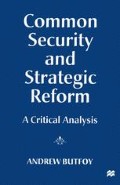Abstract
At the heart of the concept of the security dilemma is the idea that defence planning can have the unintended effect of undermining security. This idea has been central to the evolution of common security thinking; it remains pivotal to many schemes for strategic reform. For instance, views on the security dilemma frequently shape and colour the debate on non-offensive defence, arms control and CSBMs.
This chapter is drawn from Butfoy, Ameliorating the Security Dilemma: Structural and Perceptual Approaches to Strategic Reform (Canberra: ANU, Department of International Relations, Working Paper, 1996/1).
Access this chapter
Tax calculation will be finalised at checkout
Purchases are for personal use only
Preview
Unable to display preview. Download preview PDF.
Notes
This section is mostly drawn from the following: Michael Howard, The Lessons of History (New Haven: Yale University Press, 1991;
Charles Maier, ‘Wargames: 1914–1919’, in Robert Rotberg and Theodore Rabb (eds), The Origin and Prevention of Major Wars (Cambridge: Cambridge University Press, 1989);
Robert Massie, Dreadnought: Britain, Germany and the Coming of the Great War (London: Pimlico, 1993);
Scott Sagan, ‘1914 Revisited’, in Richard Betts (ed.), Conflict After the Cold War: Arguments on Causes of War and Peace (New York: Macmillan, 1994);
Jack Snyder, The Ideology of the Offensive: Military Decision Making and the Disasters of 1914 (Ithaca: Cornell University Press, 1984);
Marc Trachtenberg, History and Strategy (Princeton: Princeton University Press, 1991); and Samuel Williamson, ‘The Origins of World War One’, in Rotberg and Rabb (eds), The Origin and Prevention of Major Wars.
Nicholas Wheeler and Ken Booth, ‘The Security Dilemma’, in John Baylis and N.J. Rengger, Dilemmas of World Politics: International Issues in a Changing World (Oxford: Oxford University Press, 1992), p. 30.
Robert Jervis, Perception and Misperception in International Politics (Princeton: Princeton University Press, 1976), p. 64.
Thomas Schelling, The Strategy of Conflict (Cambridge: Harvard University Press, 1960, 1980), p. 207.
See, for example, Barry Posen, ‘The Security Dilemma and Ethnic Conflict’, in Michael Brown (ed.), Ethnic Conflict and International Security (New Jersey: Princeton University Press, 1993).
Richard Ned Lebow, ‘The Soviet Offensive in Europe: The Schlieffen Plan Revisited?’, International Security, 9:4 (Spring 1985), p. 50.
For a detailed discussion of this issue see Sean Lynn-Jones, ‘Offense-Defense Theory and Its Critics’, Security Studies, 4:4 (Summer 1995), pp. 660–91. But note that Lynn-Jones does not approve of the term offence dominance, instead he writes about the ‘offence-defence balance’. For a survey and critique of efforts to define the offence-defence balance,
see Jack Levy, ‘The Offensive/Defensive Balance of Military Technology’, International Studies Quarterly, 28 (1984), pp. 219–38.
Stephen Van Evera, ‘Primed for Peace: Europe after the Cold War’, in Sean Lynn-Jones and Steven Miller (eds), The Cold War and After: Prospects for Peace (Cambridge: MIT Press, 1993), pp. 197–8.
Robert Jervis, ‘Cooperation under the Security Dilemma’, World Politics, 30:2 (January 1978), pp. 167–214; emphasis added. For a further example of the mechanistic nature of this sort of analysis, consider the following quote from p. 195: ‘Borders across which an attack is easy tend to be unstable. States living within them are likely to expand or be absorbed. Frequent wars are almost inevitable...’. This does not seem be very helpful in explaining contemporary North America or Western Europe. Nor does the suggestion that, given offence dominance: ‘Cooperation among status quo powers will be extremely hard to achieve’ (p. 211). Later Jervis introduced significant additonal qualifications to these sorts of structuralist argument; see his ‘Realism, Game Theory and Cooperation’, World Politics, 40:3 (April 1988), pp. 317–49.
Philip Webber, New Defence Strategies for the 1990s: From Confrontation to Coexistence (London: Macmillan, 1990) p. 4.
Webber, New Defence Strategies for the 1990s, pp. 13–14. For a discussion of the risks of inadvertent nuclear escalation in Europe during the Cold War, see Paul Bracken, The Command and Control of Nuclear Forces (New Haven: Yale University Press, 1983).
On the idea of a ‘democratic peace’, see John Owen, ‘How Liberalism Produces Peace’, International Security, 19:2 (Fall 1994), pp. 87–125;
for an alternative view see Christopher Layne, ‘Kant or Cant: The Myth of the Democratic Peace’, International Security, 19:2 (Fall 1994), pp. 5–49. For a discussion of the ‘social construction’ of much that passes for objective givens in world affairs, see Wendt, ‘Constructing International Politics’.
Stephen Walt, The Origins of Alliances (Ithaca: Cornell University Press, 1987), pp. 5, 21–6 and 263–6.
Author information
Authors and Affiliations
Copyright information
© 1997 Andrew Butfoy
About this chapter
Cite this chapter
Butfoy, A. (1997). The Security Dilemma. In: Common Security and Strategic Reform. Palgrave Macmillan, London. https://doi.org/10.1007/978-1-349-25531-3_2
Download citation
DOI: https://doi.org/10.1007/978-1-349-25531-3_2
Publisher Name: Palgrave Macmillan, London
Print ISBN: 978-1-349-25533-7
Online ISBN: 978-1-349-25531-3
eBook Packages: Palgrave Political & Intern. Studies CollectionPolitical Science and International Studies (R0)

